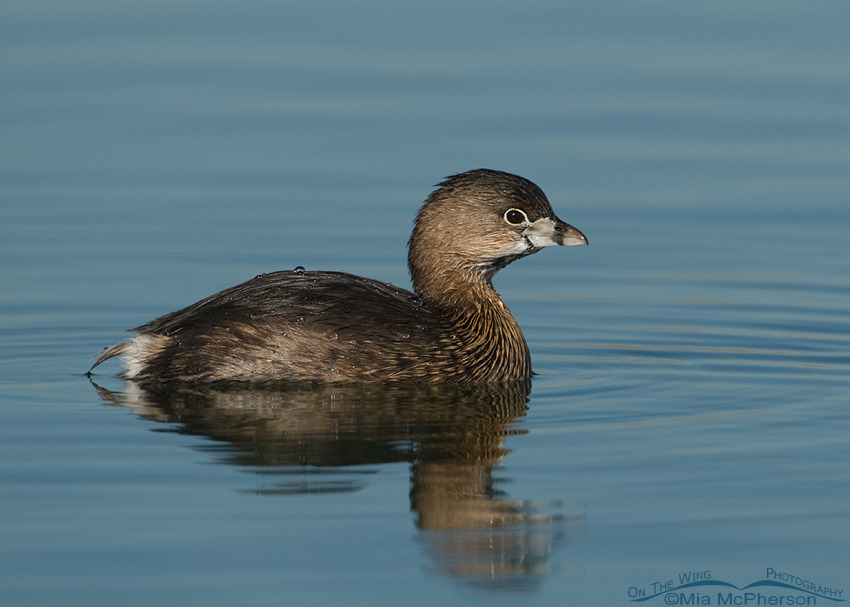 Adult Pied-billed Grebe in breeding plumage
Adult Pied-billed Grebe in breeding plumage
This is how we normally see Pied-billed Grebes (Podilymbus podiceps) – floating on the water. This adult in breeding plumage was photographed near where I live at a local pond in December of 2009.
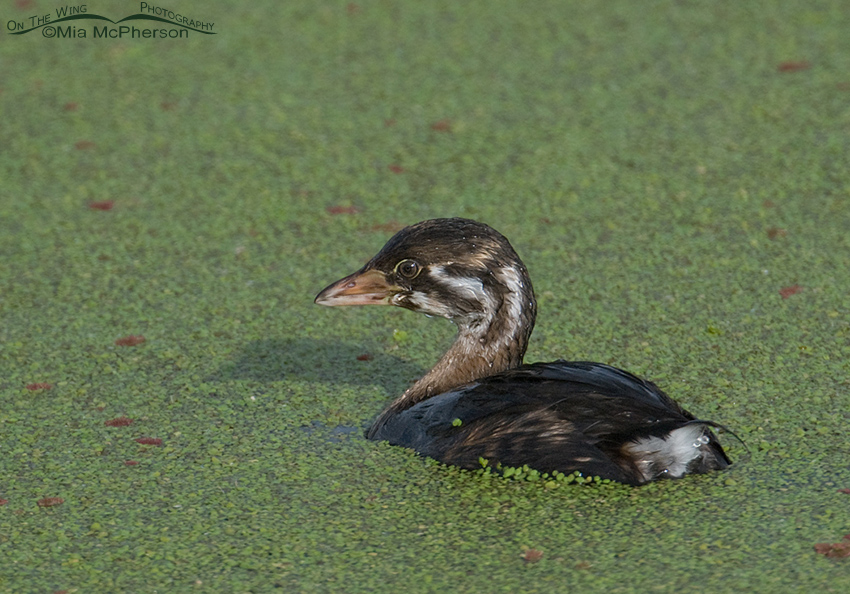 Juvenile Pied-billed Grebe in duckweed
Juvenile Pied-billed Grebe in duckweed
I photographed this juvenile Pied-billed Grebe at Farmington Bay Waterfowl Management Area on a visit to Utah in October of 2008 before I moved here. The Duckweed just about covered the whole surface of the pond.
Because of the posterior placement of the legs and feet Grebes have a very difficult time standing or walking on solid ground.
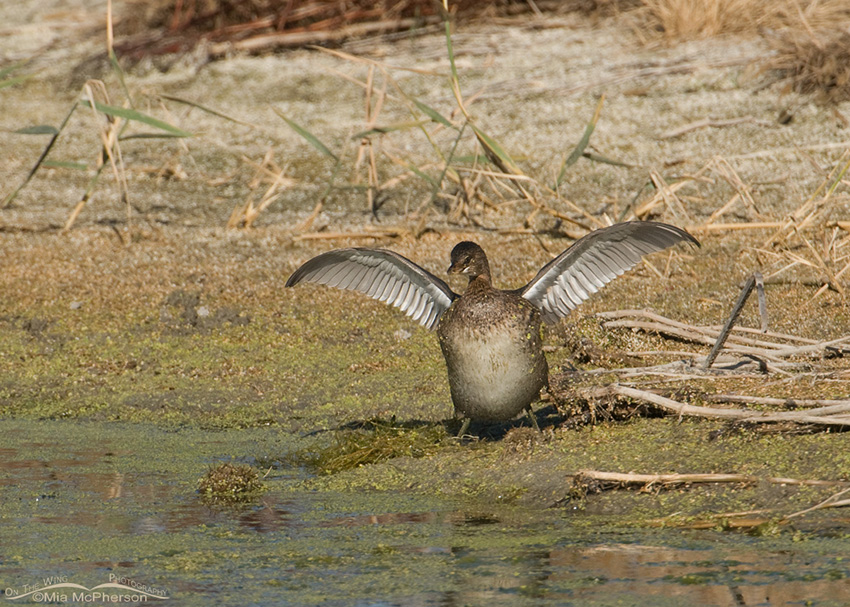 Adult Pied-billed Grebe out of the water
Adult Pied-billed Grebe out of the water
On September 21, 2009 I saw several Pied-billed Grebes out of the water walking and standing on solid ground while photographing birds at Farmington Bay Waterfowl Management Area. Doesn’t this grebe look barrel-chested? We don’t normally get a view of a Pied-billed Grebe like this one.
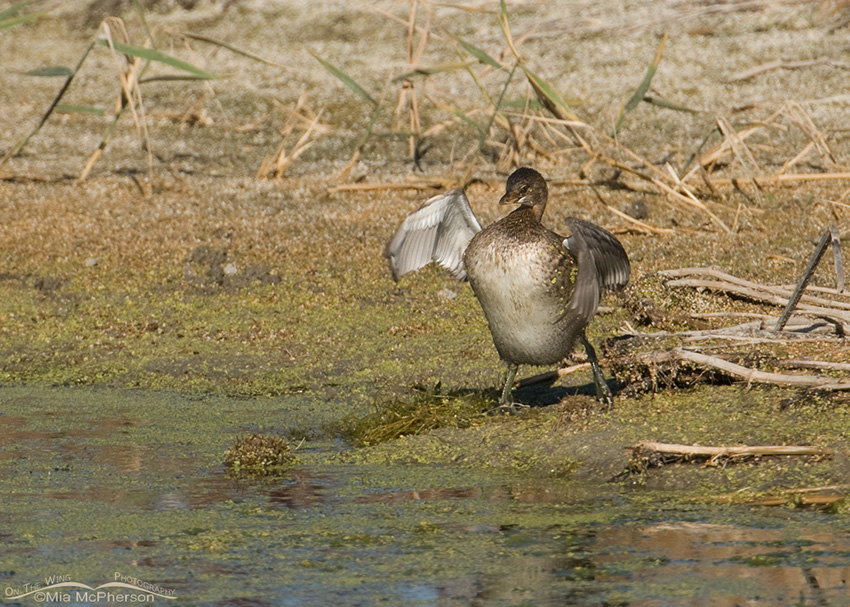 Adult Pied-billed Grebe flapping its wings while standing
Adult Pied-billed Grebe flapping its wings while standing
This image was taken the same day as the one above and it is the same grebe flapping its wings as it walked towards the water.
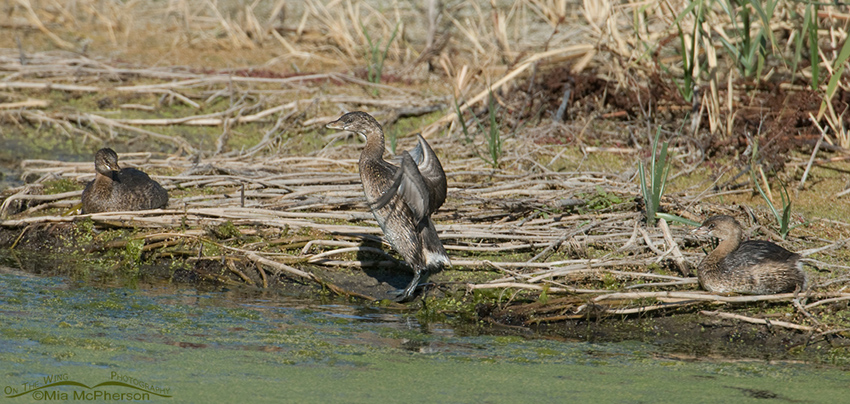 Three Pied-billed Grebes out of the water
Three Pied-billed Grebes out of the water
On the same date I saw several Pied-billed Grebes out of the water, some of them were resting (far left and right) while others were actively walking or flapping their wings while standing in an upright position.
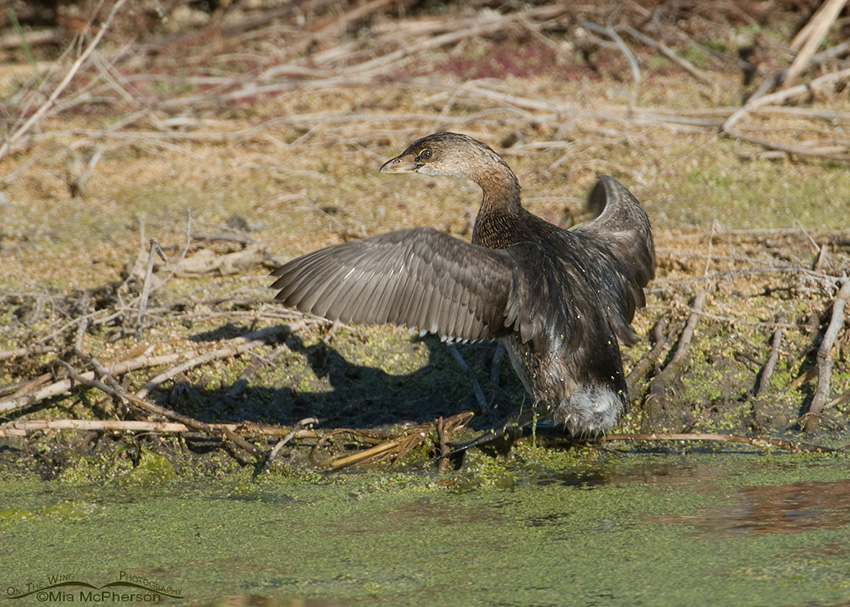 Standing Pied-billed Grebe adult
Standing Pied-billed Grebe adult
Three days later, September 24, 2009, at the same pond at Farmington Bay WMA there were more Pied-billed Grebes walking and standing on the shoreline while a few others floated on the water’s surface.
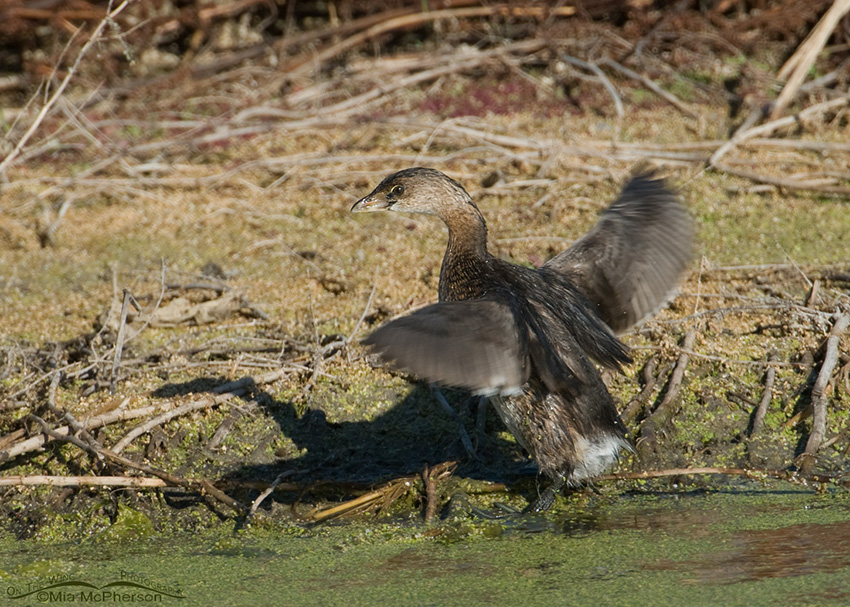 Adult Pied-billed Grebe flapping its wings
Adult Pied-billed Grebe flapping its wings
I think this image shows how far the legs and feet of Pied-billed Grebes are placed at the back of their bodies very well.
Around the time period these standing grebe images were taken there was an outbreak of Avian botulism that was killing grebes, ducks and other water birds in the Salt Lake Valley.
“Avian botulism is a naturally occurring toxin in marshes, activated by warm temperatures and a lack of oxygen in the water. Outbreaks generally happen every August along the Great Salt Lake marshes.” – Salt Lake Tribune (click here to read the article)
I’m not a scientist or a wildlife biologist, I am just a bird photographer who studies my subjects as I photograph them in the field but I did wonder if these Pied-billed Grebes instinctively knew that being in the water during the avian botulism outbreak of 2009 was a risk to their health and if that was why they were resting, walking around and standing on the shoreline of the pond. I suppose a biologist who studies Pied-billed Grebes might know the answer to that.
It was an unusual experience to see these Pied-billed Grebes standing upright and walking on the edge of this pond, some might even consider it rare. I know I haven’t seen or photographed them walking or standing since the 24th of September in 2009. You just never know what you might see while out in nature.
Life is good.
Mia
Click here to see more of my Pied-billed Grebe photos plus facts and information about this species.


Hi! I do not remember if I ever saw this one? But I love seeing them. It is like you could reach out and touch them. Your picture are so life like! Keep up the great work
Mom, because Farmington was still closed when you were here I didn’t get to show you the Pied-billed Grebes, maybe another time?
They really do look awkward standing on the shore. When I posted an image of a grebe standing on the shore at Antelope Island last year, one of my blog friends from Belgium remarked that a grebe seen on land might be sick.
Julie, it is possible that your Grebe was ill but sometimes I think they just want a break from being in the water and will rest on land. Thanks for commenting.
Ditto to all of the above. It’s great to see them on their feet and how large their “barrel chest” is… of course a necessity for those long stretches under water…. but I’m so glad to see how their shape shifts on dry land. It looks as if they struggle a bit on land… no wonder they are in the water so much.
Thanks Merrill, they do struggle quite a bit on land.
Mia:
Interesting post. I’ve never seen Pied-billed out of the water. Photos excellent, as usual.
Dave
Thanks Dave, I haven’t seen them out of the water since these were taken either!
Great post Mia, love these close ups of the birds different qualities – have to say that juvenile is very cute too.
Thank you Dan!
Awesome post and photos Mia! I have seen plenty of Pied-billed Grebes but never standing on land like this. The closest thing to this I have seen is when they climb up on their floating nests but even watching that activity, I never saw them standing with wings flapping! Very amazing and very cool!!
Thanks Larry, until I took these I had never seen them on dry ground either so I was thrilled to see and photograph these. Thanks so much for commenting.
Fantastic shots!!! I agree….do they know? And I think the answer is yes for some species. Great photo opt:)
Thanks Chris!
Excellent documentary of this rare bird. The other thing that occurs to me is that when they nest or look for mates at some point they must walk on some dry land as part of this nesting process.
Maria, usually grebes make floating nests of vegetation which I’m guessing makes it easier for them to get on their nests. As for looking for mates they find them on the water or fly at night to another body of water. Thanks for commenting.
You are right very unique. I love the way they submerge like submarines.
Nice photos.
Earl, I love the way they submerge too. Thanks for commenting!
Woah! It does happen…
Great shots Mia. This may be some of the most important bird documentation ever recorded
Laurence,
I’m working on getting images of an Ivory-billed Woodpecker, now that would be very important!
Fantastic photos of the Pied-billed Grebes and the offspring.
Thank you Bob!
Fantastic post, Mia! I am used to seeing grebes floating floating in the water, so it’s especially wonderful to view your fabulous captures. The grebes look so tiny in the water and much more substantial on land. Those spread wings shots are great. Love them all!
Thanks you Julie, they do look larger out of the water than in it!
A very informative post and great photos. Also thanks for the shoutout.
Thanks Bob, glad to give you a shout out!
excelent captures
me too, i like when i doscover somes rarity
see you soon
Thanks eric, take care!
Amazing images, Mia. I took some photos during my Sept. camping trip of juvenile grebes practicing their mating “dances.” Of course, those are on water, but they came right up to the shoreline, too. Wonder if at that time of year, juveniles do this and because of the “ick” factor of the water, they did it on land? In any event, a fabulous capture of rarely seen activity.
Tami, seeing any grebe rushing is amazing!It was not breeding season when these images were taken so I don’t think they were on dry ground to rush.
Some very unique images there Mia.. definitely an example of ‘on the wing’ photography ( had to use this thought here ;). I found the ‘duckweed’ shot really enticing. Hopefully they do have mechanisms to detect toxins but I think I read somewhere they do not. Anyway,.interesting and informative and superb photos
The Duckweed did make for some great settings for these grebes Stu. You just never know what you might see when out photographing nature!
What an awesome post, very unusual behavior and I really hope your speculations about it prove true, I love these little grebes:)
Thanks Susan, it was awesome to see this behavior on two different days.